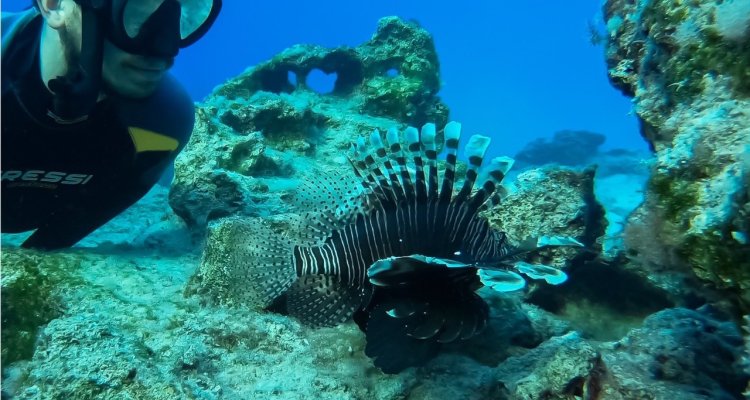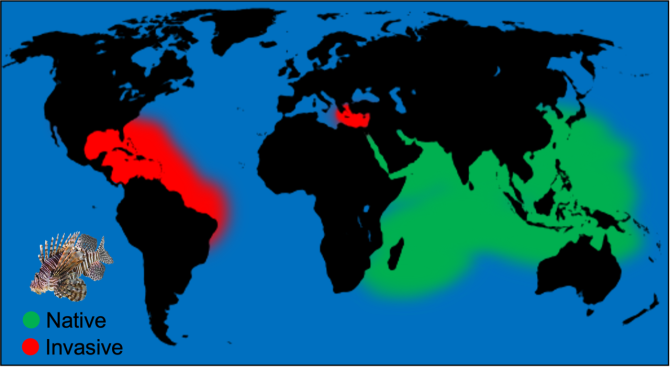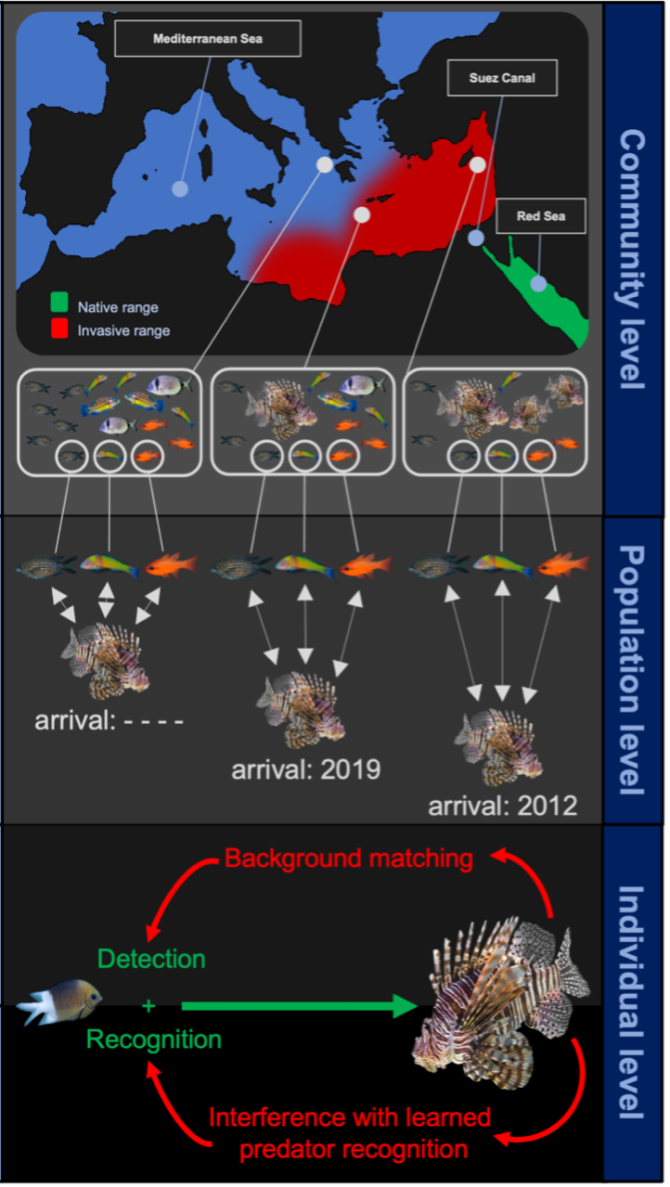
Learning from the best: studying how the most successful predator on our planet has become the most invasive fish in the marine realm
WIAS Magazine - Fall edition 2023
Research Overview
Key words: Lionfish, Pterois miles, Pterois volitans, Invasion Ecology, Invasive Species, Predation Ecology, Mediterranean Sea
I have always been amazed by the diversity of fishes: there are more species of fish than there are species of birds, amphibians, reptiles and mammals combined. Since I can remember, I have had fun looking for fishes in any water body that I come across and I still find it impossible to be close to a pond and not look into it to find out what species it harbours. My genuine interest for observing fishes in their natural environment made me soon realise that almost everywhere you look, you will find some species that do not belong there. These so-called exotic, non-native, alien or allochthonous species can reach their new ranges in various ways and when they grow fast in population density, they gain the status of invasive. There are countless examples of invasive species and I find it intriguing how they manage to become successful in environments that are often far and markedly different from those that they evolved in. One of the best documented invasions in aquatic ecosystems is that of my study species: lionfish.
Lionfish as exceptional invaders and predators
Two species of lionfish (Pterois miles and Pterois volitans) are widely spread in the aquarium trade because of their attractive morphology and colouration and they are virtually impossible to distinguish based on morphology. Lionfish are native to the Indo-Pacific Ocean and aquarium releases in the 80’s resulted in the introduction of a few individuals in the Caribbean, giving rise to one of the most dramatic invasions in the marine realm. In a few decades, lionfish have colonised the entire Caribbean, the gulf of Mexico and they keep expanding their range today along the Brazilian coast (fig. 1). Lionfish are voracious predators, feeding extensively on the local fishes, especially from those species that are closely associated with the bottom of the sea. This has a profound impact on the recruitment of juveniles and reduces the abundance of native species of high ecological and economic value.
More recently (around 2012), a second lionfish invasion began in the Mediterranean Sea. Here, lionfish were first considered invasive when they were spotted in large aggregations on the coasts of Cyprus. We now know that they entered through the Suez Canal, which is an artificial canal connecting the Red Sea and the Mediterranean. The Mediterranean is a temperate/sub-tropical sea dominated by rocky reefs, seagrass meadows and sandy patches, offering a very different habitat from the coral reefs of the Indo-Pacific and Caribbean. Despite these habitat differences, lionfish are already abundantly present in the whole eastern Mediterranean and are expanding westwards (fig. 1).
As often happens with invasive species, their rapid spread into a new environment and the possible economic and ecological consequences raised a lot of scientific interest around lionfish. One of the interesting aspects that emerged from multiple studies is that they hunt with a specific and peculiar strategy: they stalk their prey by slowly following them for several minutes before suddenly striking and swallowing them whole. Despite the conspicuous appearance of lionfish and their slow movements, prey often do not react at all while they are stalked, resulting in lionfish catching up to 85% of the prey that they target. This is the highest strike success rate ever reported in a predator in the wild. Their high effectiveness as predators is often reported as one of the traits that make lionfish the successful invaders that they are.
My project
After working on invasive lionfish in Cyprus for my master thesis, I decided to tackle some of the many mysteries that remain on their invasion and predation ecology through a PhD project, which I designed together with multiple supervisors. My project was funded through a fellowship from the WIAS graduate programme and spans across multiple ecological levels (fig. 2). Working across different disciplines is incredibly stimulating because I can learn a lot from the experts supervising me in the various disciplines that are included in my project: animal behaviour (Alexander Kotrschal and Marc Naguib from BHE and Bart Pollux from EZO), biodiversity monitoring (Reindert Nijland, from MAE) and wildlife conservation (Patrick Jansen, from WEC). We are currently working to answer three major questions on the invasion and predation ecology of lionfish.
1. What is the effect of lionfish on the fish community of the Mediterranean Sea?
Ecological studies on lionfish in the recently invaded Mediterranean are incredibly scarce. Although we know that they feed extensively on local fishes, no one has quantified the effects that this new predator is having at the community level. We will study this through a long-term exclusion experiment in Crete, Greece. We will remove lionfish from underwater sites (exclusion sites) and monitor how the fish community responds in terms of species composition and abundance. We will use both visual surveys conducted on SCUBA gear and eDNA metabarcoding to monitor the fish community. Because lionfish have been abundant in Crete for around a decade, we are expecting an overall increase in the abundance of native species at our exclusion sites, particularly for small species that are closely associated with the bottom of the sea. Our experiment will include control sites (inclusion sites) where we will monitor the fish community without removing any lionfish.
2. Can prey populations adapt to the presence of lionfish?
When an area is invaded by a new predator, the local species have to deal with an animal with which they share no coevolutionary history. This can result in prey not reacting appropriately when attacked by the predator, a phenomenon known as prey naïveté. In theory, prey naïveté can be counteracted by evolutionary adaptation after some generations of coexistence between local prey and the new predator. However, studies testing for this hypothesis are scarce and often contradicting. We will study whether prey populations are adapting to lionfish by taking advantage of a natural gradient in the time of coexistence between prey and lionfish in the Mediterranean. The lionfish invasion started in the easternmost part of the sea about 10 years ago. Since then, lionfish have been expanding westwards and are now colonising the waters around southern Italy. Hence, the same prey species have been coexisting with lionfish for different lengths of time across the Mediterranean. We will catch individuals of the same prey species from different parts of the Mediterranean and test how they react to an approaching lionfish in the same controlled conditions.
3. How do lionfish prevent their prey from reacting while stalked?
There may be two factors at play when prey do not react in the presence of a predator. First, they may simply not be realising that the predator is there (lack of detection). Second, they are aware of the presence of the predator, but they do not recognise it as a threat (lack of recognition). Although lionfish appear very conspicuous, they could camouflage through background matching because they often hunt in environments that are full of complex structures such as corals or algae. To study the intriguing idea that lionfish avoid detection in prey, we will observe lionfish-prey interactions in a controlled environment where we can easily manipulate the background of a hunting lionfish. We will also test whether lionfish interfere with recognition by prey. We will train prey to recognise lionfish and other predators through video presentations, which allow for a high degree of standardisation of behavioural trials. Using videos, rather than real predators, will also allow us to train prey using animated 3D models of lionfish in which we can easily manipulate the colouration and morphology of the predator. This will allow us to pinpoint which traits of lionfish morphology and colouration contribute to making them the exceptional predators that they are.

Figure 1. Overview of the native (green) and invasive (red) ranges of lionfish (Pterois miles and Pterois volitans).

Figure 2. Schematic overview of the three ecological levels comprised in my project. At the community level, we will test for the impact of the lionfish invasion on the presence and abundance of local fish species. At the population level, we will test for adaptations to lionfish in prey from areas that have been invaded by lionfish at different times. At the individual level, we will test for the relevance of background matching and interference with learned predator recognition in lionfish-prey interactions. These mechanisms could interfere with two key steps needed for prey to react to a predator: detection and recognition.





